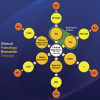How early can we diagnose Alzheimer disease (and is it sufficient)? The 2017 Wartenberg lecture
- PMID: 30089620
- PMCID: PMC6133623
- DOI: 10.1212/WNL.0000000000006088
How early can we diagnose Alzheimer disease (and is it sufficient)? The 2017 Wartenberg lecture
Abstract
A seismic shift in our understanding of the ability to diagnose Alzheimer disease (AD) is occurring. For the last several decades, AD has been a clinical-pathologic diagnosis, and this conceptualization of the disease has served the field well. Typically, the clinician would identify a syndrome such as mild cognitive impairment or dementia, and label the condition as "probable AD" since the diagnosis of definite AD could not be made until an autopsy revealed the presence of amyloid plaques and tau-based neurofibrillary tangles. However, with the advent of biomarkers for AD including neuroimaging and CSF, the identification of AD pathology can be made in life, which greatly enhances the ability of clinicians to be precise about the underlying etiology of a clinical syndrome. Hypothetical models of the temporal relation among the pathologic elements and the clinical symptoms have been proposed and have influenced the field enormously. This has enabled clinicians to be specific about the underlying cause of a given clinical syndrome. As such, the diagnostic capability of the clinician is evolving. However, AD pathology is only a component of the puzzle describing the causes of cognitive changes in aging. Most often, there is a multitude of pathologic entities contributing to the neuropathologic explanation of cognitive changes in aging. AD changes contribute important elements to the diagnosis, but the final answer is more complex. The field of aging and dementia will have to incorporate these additional elements.
Copyright © 2018 The Author(s). Published by Wolters Kluwer Health, Inc. on behalf of the American Academy of Neurology.
Figures





References
-
- Alzheimer's Association. 2018 Alzheimer's Disease Facts and Figures. Alzheimers Dement 2018;14:367–429.
-
- Alzheimer A. Uber eigenartige Krankheitsfalle des spateren Alters [in German]. Zeitscrift Gesamte Neurologie Psychiatrie 1911;4:356–385.
-
- Blessed G, Tomlinson BE, Roth M. The association between quantitative measures of dementia and of senile change in the cerebral grey matter of elderly subjects. Br J Psychiatry 1968;114:797–811. - PubMed
Publication types
MeSH terms
Grants and funding
LinkOut - more resources
Full Text Sources
Other Literature Sources
Medical
Research Materials
